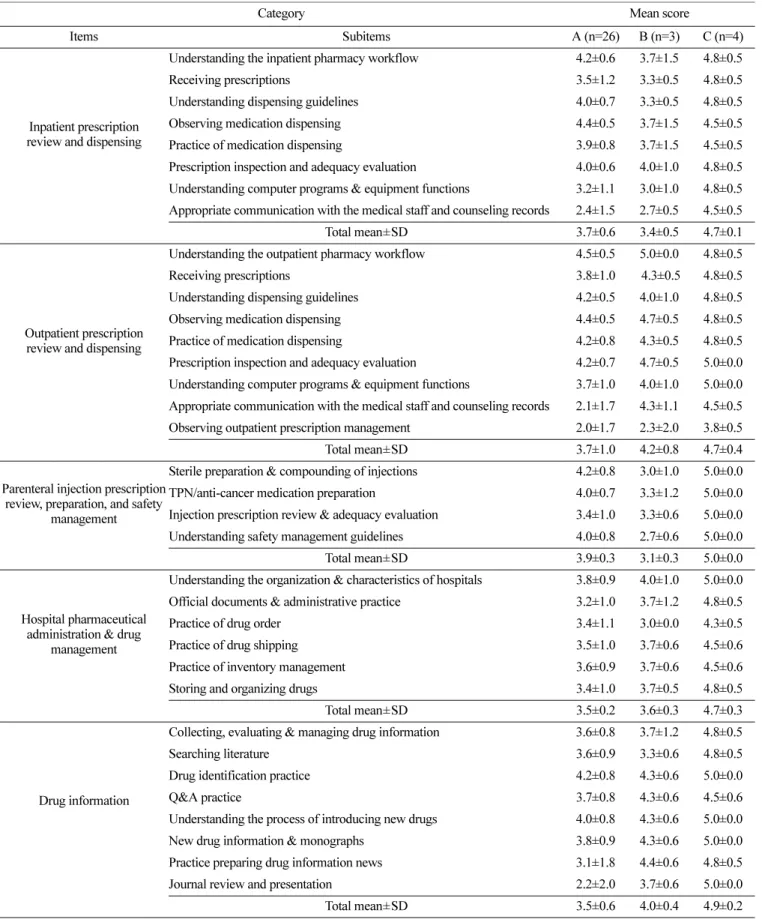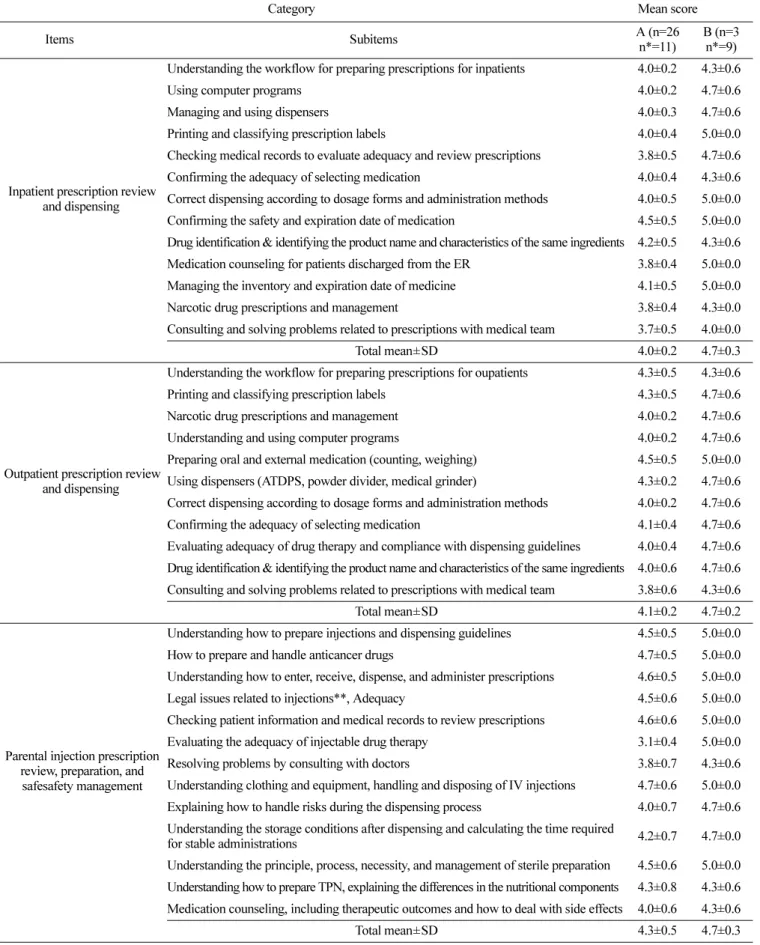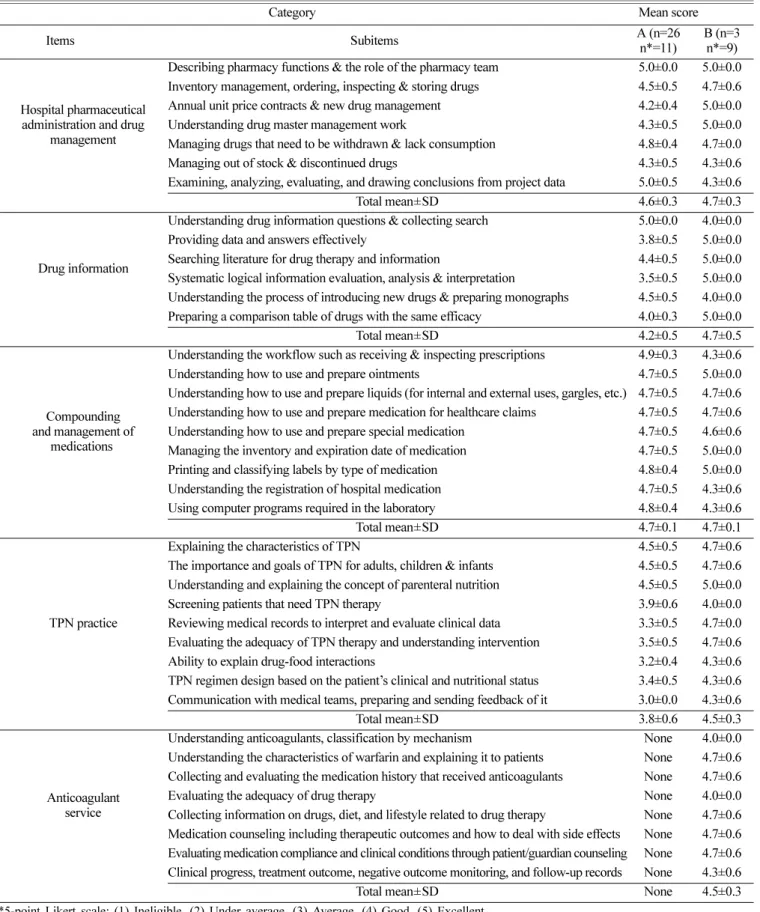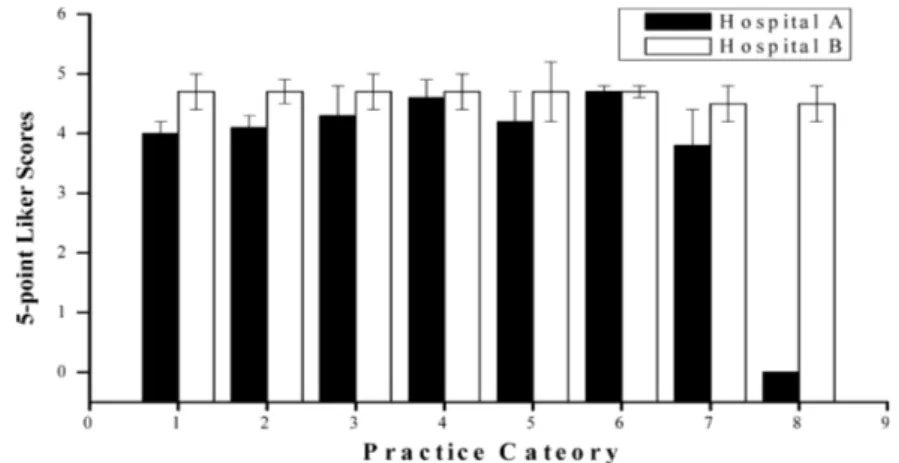DOI 10.17480/psk.2020.64.6.475
종 설(Review)
A Comparison of the Satisfaction and Evaluation of Hospital Pharmacy Practice Experience between Pharmacy Students and Preceptors
Young Ah Cho*
,†, Jinkyung Ock**
,†, Sujung Lee**, Seoyoung Jung**, Jiwon Cho**, Kyungeun Lee**, and Hyonok Yoon**
,#*Mokhwa Convalescent Hospital
**College of Pharmacy, Research Institute of Pharmaceutical Sciences, Gyeongsang National University
(Received June 24, 2020; Revised October 27, 2020; Accepted December 16, 2020)
Abstract In this study, we analyzed a questionnaire to determine student satisfaction regarding the training during hospital pharmacy practice. This study was conducted to evaluate the learnings during the hospital pharmacy practice course undertaken by students (n=33) enrolled at the Gyeongsang National University (GNU) College of Pharmacy in 2019. Moreover, we evaluated the apprenticeship of preceptors (n=29) with respect to the practical achievement of students who completed the hospital pharmacy practice course. The items in the student survey questionnaire were prepared by referring to the hospital pharmacy practice manual for preceptors designed by the Korean Association of Pharmacy Education. The survey comprised items of several categories and the results were compared based on the average score upon evaluating the performance of each item in these categories. The students gave high scores for parental injection prescription review and preparation, as well as safety management and outpatient prescription review and dispensing. For items of parental injection prescription review and preparation, hospital A received a score of 3.9±0.3 and hospital C received 5.0±0.0. For items of safety management outpatient prescription review and dispensing, hospital B received a score of 4.2±0.8. The students gave low scores in clinical pharmacokinetics practice, with hospital A, hospital B, and hospital C receiving 2.6±0.4, 2.2±0.2, and 3.7±0.9 respectively. The preceptor's evaluation of students showed high scores for the compounding and management of medications, with hospital A receiving 4.7±0.1 and hospital B receiving 4.7±0.1.
Low scores were received for total parental nutrition practice, with hospital A receiving 3.8±0.6 and hospital B receiving 4.5±0.3. Especially, for the subitems of communication with medical teams, and preparing and sending feedback, hospital A awarded a score of 3.0±0.0, whereas hospital B gave 4.3±0.6 to the students. The results will contribute to understanding the quality of hospital pharmacy practice and preparing for the improvement of the program.
Keywords hospital pharmacy practice, survey, pharmacy students, pharmacy practice category, preceptor, hospital pharmacy practice manual
Introduction
The College of Pharmacy at Gyeongsang National University (GNU) provides the clinical practice course for sixth graders who have completed their introductory pharmacy practice experience in the second semester of the fifth grade. The clinical practice course consists of six sessions, with each session lasting five weeks.
1)The students must complete courses in hospital pharmacy practice experience 1 and 2, community pharmacy practice, pharmacy practice, and advanced research practice over six sessions.
1)Seminars were held at the college on the last Friday of each session to check the progress of the program.
1)The contents of the hospital pharmacy practice experience course are organized by referring to the hospital pharmacy practice manual for preceptors by the practical training committee of the Korean Association of Pharmacy Education (KAPE). The students received training in inpatient prescription review and dispensing, outpatient prescription review and dispensing, medication counseling for general patients, counseling for patients taking certain medications, parenteral injection prescription review, preparation, safety management, and total parental nutrition (TPN) practice. Training was also provided for high-risk drug therapy, in- hospital pharmaceutical administration, drug management, drug information, therapeutic drug monitoring, and clinical pharmacokinetics practice.
2)Student achievements are evaluated by the preceptors.
2)Some hospital pharmacies use this manual to prepare their evaluation tables or scorecards to train and evaluate students.
†
These authors contributed equally to this work.
#




